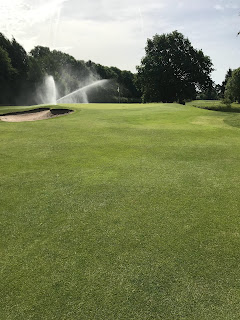Hello all
It's October 6th and we are forecast several days of 20 something degrees, sunshine and no rain, at least until the middle to back end of next week. Let's look forward to that as the previous 3 months have been wet. July posted the same amount of rainfall than January, February, May and June combined. August and September didn't exactly crack the flags. Not good.
We've now got Ali back after his operation so we can hopefully start to pick things up again and get some more consistent productivity. With leaves falling and growth still good, we need to deal with multiple challenges as best as we can.
Greens maintenance week was still carried out. Thanks to Terry for providing some assistance clearing cores, matting topdressing sand in and a few other small tasks.
Often, this work is carried out following our annual soil tests. The most problematic green is the 5th. In all honesty, the root zone is poor. Although it is sandy, it has a high percentage of fine sand particles. These are not conducive to good drainage. Hence the green is slow to dry down after rain and can hold excess moisture in the top part of the soil profile. So, we hollow cored this green to a 50mm depth and backfilled with our dressing sand - a coarse/medium mix. This should help to draw rain through a bit quicker. Following this, we also scarified it to pull a bit more thatchy material out. The soil test for this particular green showed no real organic matter issues; 2.2% is not an excess. It is simply the poor root zone.
The other greens all received a double scarify, double verticut, were overseeded and fertilised. We just need to remove the seasonally accumulated organic matter and this is always in the top 12mm (0.5 inches) as that is where the majority of growth and excess plant material is based. Overseeding is purely to keep pushing browntop and creeping bentgrass into the sward for a better quality surface. The lack of overly invasive work now means that the recovery from this work is fairly quick. 7-10 days and there is little evidence of any work being done.
The fairway scarifying was carried out, albeit in a mixed weather week. The rain did not help in the slightest. We removed a lot of dry, dead, matted material accumulated in the drought spell. Doing this annually has certainly helped with fairway drainage. If the soil has less thatch in the surface, less water will be held in the surface and so surface puddling in the wetter months will be less of an issue. Do the work, reap the benefits.
We have had a few issues, greens-wise and the first has been a bit of a pain since early July. This, as is visible in the photos, is a black algae-like growth in the surface. It is literally a millimetre thick and is a result of continuous rainfall, heavy morning dew, high humidity and very inconsistent sunlight/drying days. So the effect of greens surfaces sitting damp for long periods encourages the proliferation of it. It generally disappears with sun, warmth and wind. As there has been little of either to celebrate, here we are and because it is not a turf disease, a fungicide will not eradicate it.
So in season, verticutting and light sand dressing help to overcome this because it is has this drying effect. Now, we cannot utilise these practices because we are beyond the period of recovery for such practices - the mornings are darker for longer, daylight hours are less and soil temperatures are cooling. Therefore aeration and a higher mowing height are more suitable.
Secondly, we've had Take All patch disease (above). It's a soil borne disease and mainly associated with high sand content root zones. So our greens tick that box. Often, the prompt for this disease is a reversion from one extremes of weather to the other ie dry to wet. So we had that between June and July onwards. Tick that box. It affects poa and bentgrass. Tick that box. It doesn't affect fescue. So we have recently spot seeded the affected areas with fescue in an attempt to mitigate this disease moving forward.
The other issue - and this is confined at the moment to the 5th green, is Fusarium (above). A disease that is an airborne spreading disease, it spreads on the morning dew and is extremely detrimental because it is so destructive to the surface, attacking in heavy dews, humid conditions and often greens lacking in wind circulation & sunlight.
So we have the 5th green here in the photo. Notice the shaded area at the back of the green? Yep, that's where the Fusarium is most prominent. The correlation is obvious. Very little sunlight to evaporate the dew, a very humid and wind-free environment. Trees are nice to a degree but they are not helping here at all. This is where we are at with this green. Multiple issues and the associated problems with the soil and location. Unfortunately, the current range of fungicides is a lot less effective than what was previously available. So without any modicum of tree management in this area, disease will always be an issue on this green between September and April.
I believe the joining up of the 4th and 7th fairways has helped somewhat with the issues on the 4th hole. Balls exiting the golf course into the neighbouring houses was a huge problem. Now that we have grown the rough in down the left hand side of this hole and connected the 4th and 7th fairways, effectively losing the dividing rough, has done well.
Enjoy the autumn, we'll endeavour to keep on top of falling leaves as best we can!
Ben



























































